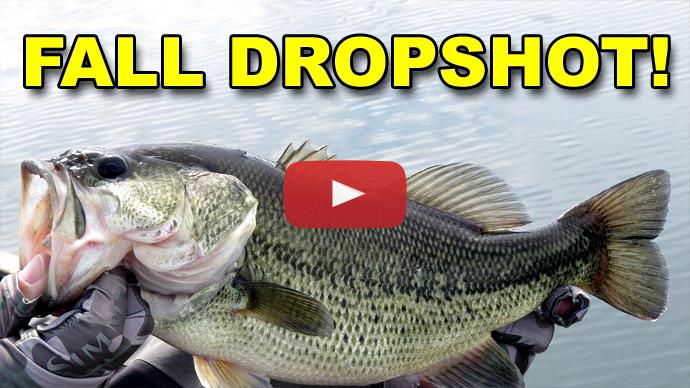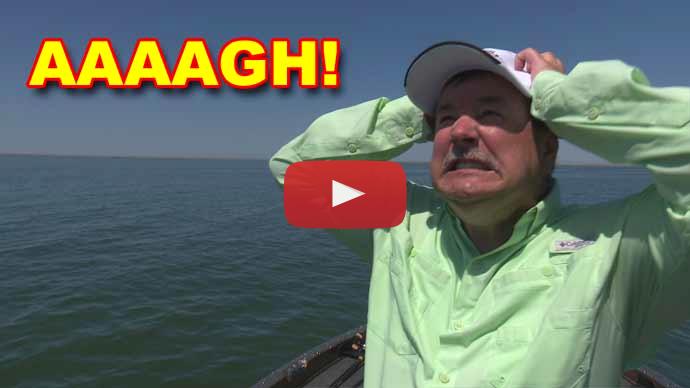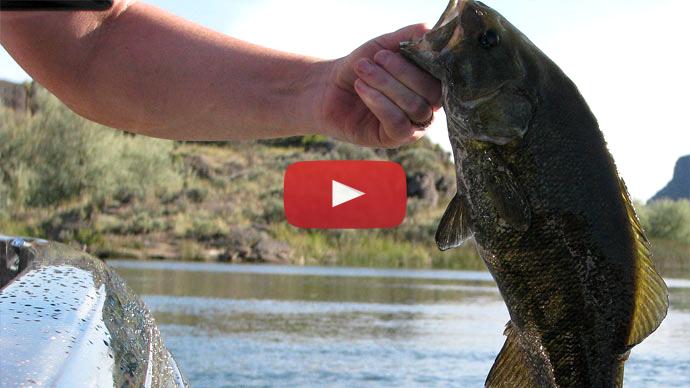Hey guys, Cliff Pirch here for BassResource.com. We're talking a little bit about Drop Shotting in the fall. And, fall Drop Shotting has a little different element to it. Most of the year...and a drop shot technique can really work year-round. Most of the year I'm fishing targets. And, you know, if you fish a lot in the fall, you know that the situations vary. You might have some fish shallow targets, you might have some fish deep on the edges of breaks, but you're also gonna have that suspending fish. A lot of times those fish are just all over the water column in the fall. So, the Drop Shot is a good technique for that because not only can I fish targets that I see on my electronics or visually see out there, I can fish those suspended fish down there.
And, what I like to do a lot is drop that bait down into the school of fish. If I'm fishing some of those suspended fish, I like to drop it down into 'em or above 'em. I don't really like to go below 'em too much unless you can notice that they're chasing it to the bottom. And, with the new electronic age, you can see a lot of what's going on down there. They really tell you the story of what's gonna work best for you when you see how they react. But in general, I like to keep it above them. And so, if I'm fishing that open water, fall suspended fish pattern, I'm generally gonna be a really light line. It's generally gonna be really on light line in the fall. You know, you can vary it when you're fishing cover in different times of the year, but in the fall, I really like light line. One, I can open the bail on a spinning reel and it'll fall. I mean, it'll just drop like a rock. I can get it down to 'em quick, you know, I don't have to peel line off of a baitcaster. A spinning reel, I can get it down there. And the smaller diameter line I've got, the faster I can get it to 'em. You know, they're following bait fish. You know, a lot of times they're on shad and they're traveling, and you gotta get it in front of 'em quick, get their attention quick. So, I like a spinning reel. I can open that bail, send it down there and get it to 'em quick. So, that's a big benefit of the spinning reel and the Drop Shot on light line.
So, as far as the setup goes, I might use a similar leader length, like just a 12 to 14-inch length. You could go a little longer. If you want to get that bait out of...or the bait away from the focus on the weight, you can lengthen that a little bit, but in general, I want to get 'em to focus on that worm and I can get that down there, you know, in the strike zone or right above 'em. A lot of times if they're looking up, they'll bite it a little bit better. So, I get it down there. I'm using a light wire hook. I'm still using the same little straight shank, 1/0 light wire. It's Gamakatsu 1/0 light wire hook. And I don't want it to overpower that bait, especially when I'm fishing suspended fish. You know, I really want it to look pretty natural right there. And you can get that worm to just kind of wave or shake a little bit above them. You know, they're used to seeing a school of shad go over, you know, they get into 'em. Some of those shad might be wounded, there might be birds working them, and it's just gonna look like that real vulnerable dying bait fish or just an easy, easy target. So, that's what makes it so good. And you can also keep it there. You can keep it there. You don't have to, you know, jerk it like a jigging spoon and all that. Although that works well sometimes, sometimes just keeping this thing in the strike zone is a little bit easier that way.
All right, guys. So as far as my technique on those suspended fall fish, I really like to drop it down in there. You know, you can see 'em on your electronics, whether it's on your sonar or your forward-looking sonar. You can see what depth they're at. I want to get that bait down into the strike zone or above them. Typically it's better if it's above them and they tend to feed up better than they do down unless they're really close to the bottom. But I like to keep it above them. And I'm just gonna use just a real soft shake. I'm not gonna give it a ton of action. It's a subtle technique. It looks like something that's easy to grab. You know, they see bait fish dying from birds feeding on 'em, bass feeding on 'em, other predators feeding on 'em, so it's a real vulnerable looking bait. I'm not gonna give it a ton of action. I'm just gonna kind of...I'm gonna get it down into that strike zone. And, you know, where I see those fish, I'm just gonna shake it a little bit, give it a little bit of action. I want that worm to just kind of waving a little bit, but it doesn't take much. It doesn't take much. And if you're giving it too much action, you might not recognize the bite. So, that line, it may go slack. If it goes slack and you know that there's nothing there, well, you need to wind and set the hook. You know, a fish has grabbed it and come up with you anytime you got slack on it. You might feel a tick or you might feel pressure, same thing. You don't wanna be given it a ton of action because you might miss that, you know, and they may not hang onto it long.
You've got this weight down here. So, you know, when the weight's on the bottom, I've got a little more slack in my line. When the weight's hanging, they've got a little more tension on there to feel that something's a little funny and, you know, they might not give you as long to set the hook on 'em. So, anytime the line goes slack, anytime you feel pressure, anytime you feel a tick, just set the hook. Wind and set the hook.
So, not a lot of action when I'm fishing suspended fish, but a lot of fish catching if you get around a good school of 'em. You don't have to impart a lot of action, so. And again, it comes with experience. You get out there in the fall, you find a school of fish, experimenting with how it works, you'll find the zone. You'll find a nice balance of action that you like to impart. You'll get better on your hook set, your fish-fighting technique, you know, as far as being able to fight 'em on light line.
And in the fall, if you're fishing those suspended fish, there's not a lot of danger where you hook 'em unless you've got standing timber. You know, there's some places with standing timber or dock cables, stuff like that. Deep dock cables might give you some trouble. But in general, you've got less objects to worry about to get 'em away from because they're just up there suspended in that water column. So light line...
That's gonna be my Drop Shot. I've got the new Big Bite Baits, Cliff Hanger Worm, something we worked on over the last year. It's a straight tail drop shot worm. Really soft plastic, fairly buoyant. And, what I really like about the sensation of soft plastics from Big Bite, it's a new heavy, heavy, heavy-scented bait. So, if you get a fish bite it, they're more likely to hang onto it longer, you know, for you to recognize that bite. And you know, if you've got smallmouth around, they're really drawn to that heavy scent. They really use scent a lot to hone in on that stuff. So, the sensation soft plastics is really a good line because, you know, we've taken one of those good western hand pour straight tail worms that we've always used and then added that scent.
So, I really like it, but straight tail worms gonna be mostly what I want to use in the fall. I like to go with bait fish colors and bright colors. You know, a lot of the year we go real natural with the green pumpkins or, you know, those real natural colors, the watermelons and stuff like that. And those work well. But one thing I've noticed in the fall is the bright colors, the pinks, the, you know, the real light bait fish colors, things like that, they really stand out up there and a lot of times it's good in sunny conditions. You know, most of the time in the summer I'm using it in sunny conditions. And so I think that...or excuse me, in the fall, I'm using it in that, you know, that blue sky, lots of sun type of conditions and the bright colors really seem to get bit a lot more.
I've had guide trips and you can really kind of learn some things where you've got two or three guys dropping a Drop Shot down there. And what normally may work that watermelon green, stuff like that, it may not get bit as much as the guy that's got the pink or the bright orange or the, you know, the real bright ones on. And, it's just something I've noticed where they're drawn to that bright color in the fall. So I like to go bold and bright. And even in the summer, I use 'em a lot of the same ones, but I've noticed, specifically in the fall, that brightness really tends to catch those suspended fish well.
And, I'm using...I think I talked a little bit about the weight, but my 1/4 ounce weight gets it down there pretty good because I've got such light line. I'm only using the 8-pound test, you might even use six. They get a really good look at it. So, I'm using light line, and 1/4 ounce really kind of does the job for me. You could go heavier with the 3/8 or something like that, but in general, I really like a 1/4-ounce weight. It just balances well on a soft rod. And, 1/4 ounce does most of my applications, especially suspended fish fishing. And you can mess with some different baits, little shad-shaped baits, and soft stick baits. They also work really well. But, in general, I just love the straight tail worm for my Drop Shot most of the time, so.
One thing about it, is you can get really, really, really big numbers. Like, you get around a school and you can kind of be hunting and pecking around all day and get one here and one there. But when you get into a school of offshore suspended bass in the fall, you really have the potential to catch a lot of them. I'm talking, 50-fish days when you get around one of those big schools because they're just feeding up for the winter and they really group up out there, and you can really have big numbers. So it's a fun technique if you can find them and that's a good way to catch 'em. So thanks, guys. I hope you go get 'em this fall and hope that works well for you.



